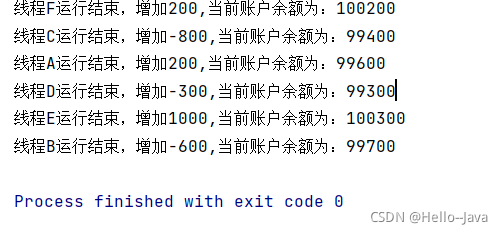同步代码块
Java虚拟机为每个对象配备一把锁和一个等候集,这个对象可以是实例对象,也可以是类对象。对实例对象进行加锁可以保证与这个类相关联的线程可以通过互斥地使用类对象的锁。
一个类的静态成员方法变量和静态成员方法隶属于类对象,而一个类的非静态成员变量和非静态成员方法属于类的实例对象。
在方法中,用Synchronized声明的语句块称为同步代码块
synchronized(synObject)
{
//关键代码块
}
关键代码块:必须获得对象synObiect的锁才能执行,当一个线程想要进入
该对象的关键代码时,JVM将检查该对象的锁是否被其他线程获得,如果没有,则JVM把该对象的锁交给当前请求锁的线程,该线程获得锁后即可进入关键代码区域。
多个线程执行的不确定性引起执行结果的不稳定
多个线程对账本的共享,会造成操作的不完整性,会破坏数据。
// 构建一个信用卡账户,初始金额为10000,模拟透支,存款等多个操作,显然,账户User对象是一个竞争资源,把修改账户余额的语句放在同步代码块中,并将
// 账户的余额设置为私有变量,禁止直接访问。
public class CreditCard {
public static void main(String[] args) {
//创建一个用户对象
User u = new User("张三", 100000);
//创建6线程对象
UserThread t1 = new UserThread("线程A", u, 200);
UserThread t2 = new UserThread("线程B", u, -600);
UserThread t3 = new UserThread("线程C", u, -800);
UserThread t4 = new UserThread("线程D", u, -300);
UserThread t5 = new UserThread("线程E", u, 1000);
UserThread t6 = new UserThread("线程F", u, 200);
//启动线程
t1.start();
t2.start();
t3.start();
t4.start();
t5.start();
t6.start();
}
}
class UserThread extends Thread{
private User u; //创建User对象
private int y = 0;
//构造方法,初始化成员变量
UserThread(String name, User u,int y){
super(name); //调用父类的构造方法设置线程名
this.u = u;
this.y = y;
}
public void run(){
u.oper(y);//调用User的对象oper()方法操作共享数据
}
}
class User{
private String code;//用户名
private int cash;//用户卡上的余额
User(String code,int cash) {
this.code = code;
this.cash = cash;
}
public String getCode(){
return code;
}
public void setCode(String code ){
this.code = code;
}
//存取款操作方法
public void oper(int x){
try{
Thread.sleep(10);
//把修改的共享数据语句放在同步代码块中‘
synchronized (this){
this.cash +=x;
System.out.println(Thread.currentThread().getName()+ "运行结束,增加" + x +",当前账户余额为:" + cash);
}
Thread.sleep(10);
}catch (InterruptedException e){
e.printStackTrace();
}
}
public String toString(){
return "User{" + "code = '" + code + '\'' + ", cash=" + + cash + '}';
}
}
